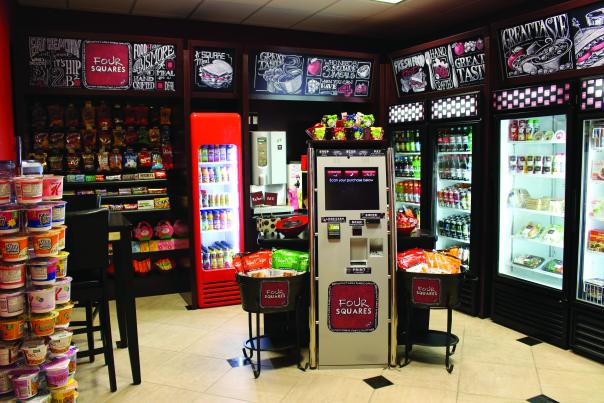
It’s late at night, you’re at work and you’re peckish. You might not really feel like it, but a bar of chocolate or a bag of crisps from the vending machine is the best you’re going to get. Catering accounts across the US are looking to change that, however.
They have found a new solution, so no one has to make do with whatever will survive in a machine: they’re setting up micromarts, a cross between a vending machine and a convenience store. They’re small units, mostly with open-air fridges, and unmanned, except for attendants who drop by from time to time to keep them stocked.
Sales at the micromarts at the six Florida Blue locations they’ve been set up are up $30,000 (£19,350) a year over the previous vending sales at the sites according to Damian Monticello, senior manager of corporate hospitality services for the health insurance company that’s headquartered in Jacksonville, Florida.
He opened his first micromart in 2011 and the latest in April this year. Four of them replaced vending options while one opened alongside a full-service cafeteria.
“We were having trouble getting people through, so the micromart helped take the burden off it,”
Monticello says. The sixth was a conversion of a traditional cafe that was seeing decreased traffic. This one is now a hybrid market that serves one hot option for each breakfast and dinner.
Florida Blue’s micromarts are open 24/7, and about half the business is taking place after the hours of a traditional cafe, which is what Monticello was hoping would happen.
“I think we’re attracting more people, who weren’t coming to a full-service cafe, who’ve brought something from home and are just looking for that extra thing to add on,” he says.
Everything is sold from traditional or open-air refrigerators “so customers can see, touch, feel anything,” he says. Bestsellers are the products that people take home, like loaves of bread and gallons of milk, as well as headphones.
Take-and-heat meals are among the most popular items, Monticello says. These are made at the vending company’s commissary, and some are shelf-stable, some are frozen and some refrigerated.
“We’re seeing a 50/50 split of sales of people coming down in the morning to buy them for lunch vs in the afternoon to eat at their desk for dinner or to take home,” Monticello says.
“Part of the reason we went to micromarkets was because we wanted people working the later shift to have something that was a meal option, not just vending.”
Next up, Monticello’s looking to introduce greeting cards and food products that are native to the specific region an office building is in.
Convenience Solutions by Sodexo in the US is putting micromarts into all kinds of facilities –healthcare operations, B&I, call centres, government buildings and more, and has almost 1,000 of them with its partner network.
Each one is customised to the location, says Shawn Murphy, product development director, and they may replace vending or a full-service location, or can also sometimes be an addition.
They generate good sales. “Where we have put markets in addition to a full-service cafe, it has not cannibalised sales – but we are careful to put them in only in the right scenarios,” Murphy says.
Because each one is customised, it takes four to six weeks to build out the location and buy the equipment. During that time, Sodexo often posts teasers saying the micromart is coming and the client may send out emails announcing its arrival.
According to Murphy, the bestseller is coffee if there’s no complimentary coffee in the building. Otherwise, fresh salads and sandwiches do well, and in blue-collar environments, frozen food sees high sales.
Unexpectedly good sales come from cheese sticks and hard-boiled eggs, especially when converting a vending machine to a micromart “just because they didn’t have access to those things,” Murphy says.
Sodexo also helps each client get the micromarts up and running. “We are there for grand-opening support; we train the operator and explain to the customer how to use it,” he says.
Typically, the contractor makes sure someone is on hand for the first couple of days after the store opens, “though, for some of the younger generations, you don’t even have to explain it. They’re so used to doing self-checkout in grocery stores.”
Magee-Womens Hospital of the University of Pittsburgh Medical Center introduced a micromart within its cafeteria in October 2013.
“We needed a healthy, fresh food option for those who work the midnight shift,” says director of food and nutritional services Chris Vitsas.
The cafeteria closes at 3pm and the micromart, unlike most others, only operates from 4pm to 6am, though during the peak lunch times, guests do use the self-checkout.
The busiest times, Vitsas says, are 4.30–6pm and 1–3am. “We see a lot of people purchasing items to take home for dinner,” he explains.
This micromart was built into the cafeteria renovation, he says, and this part of it cost just under $20,000 (£13,000), which included two open-air coolers, the self-checkout register and the security cameras.
About 95% of the food is produced daily in house – such as soups, sandwiches, salads and desserts – but pre-packaged items, like crisps and nuts, are on offer too. The bestsellers are an apple-cranberry-walnut salad and iced tea.
Before opening, Vitsas had time to get the word out about the upcoming micromart. “Once we went live, we had posters on how to create accounts, pre-load money and use the register.”
Apart from the obvious increase in sales, adding the micromart has meant hospital employees now have access to better food. Since most things are made in house, they’re healthier than pre-made items, Vistas adds.